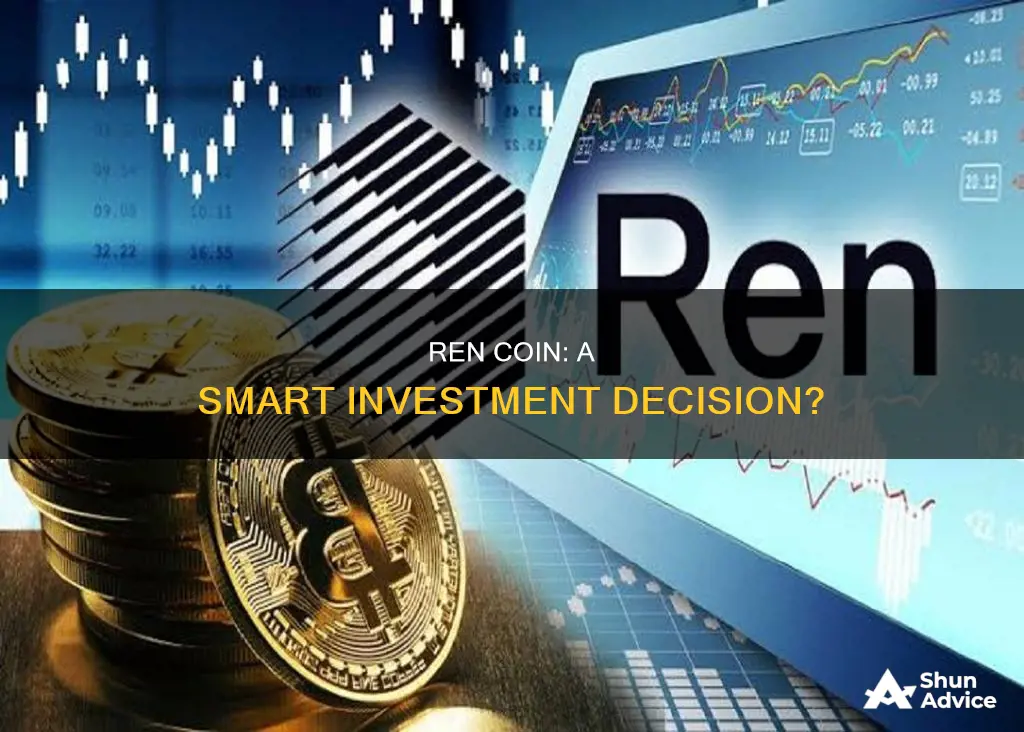
Ren (REN) is an open protocol that aims to facilitate the transfer of cryptocurrencies across different blockchains. Formerly known as the Republic Protocol, Ren was founded in 2017 by Taiyang Zhang and Loong Wang, classmates at the Australian National University. The protocol's native token, REN, is used to pay trading fees for orders made on the RenVM (Ren Virtual Machine) and to pay bonds to the Registrar, a smart contract that manages Darknodes in the Ren ecosystem. While Ren has been in the crypto market since 2018, it has failed to gain a top position, and its price history has been relatively static. As of November 2022, it was ranked as the 164th largest crypto by market cap. The token's price has seen some volatility, with an all-time high of $1.83 in February 2021 and lows of around $0.05 in June 2022. Various sources offer mixed predictions for the future price of REN, with some suggesting it could reach $0.16 in 2023 and $1.01 in 2028, while others forecast a decline to $0.008 in late 2023. Overall, while Ren has the potential to be a successful investment, it is hard to say for sure, and it is important to conduct thorough research before investing in any cryptocurrency.
What You'll Learn

Ren's price history
Rens Price History
Ren (REN) is an open protocol built to provide interoperability and liquidity between different blockchain platforms. It was founded by Taiyang Zhang, its CEO, in 2017, and was initially called the Republic Protocol.
REN first came onto the open market in February 2018, with a value of around $0.082. The price remained relatively static for the next couple of years, mostly operating between $0.04 and $0.13. The low point came on 27 November 2018, when it reached $0.01548.
There was an upsurge in September 2020, when it peaked at above $0.50, and REN continued to perform well into 2021, reaching an all-time high of $1.83 on 20 February. However, this was followed by a significant downturn, with the price falling below $0.50 for much of the summer. REN recovered somewhat in August and reached above $1 in late October, before ending the year at $0.5298.
The year 2022 saw a further decline in REN's fortunes, with the token reaching a high of $0.6131 on 3 January, before falling to $0.249 on 24 February following Russia's invasion of Ukraine. There was a brief recovery, with REN hitting $0.5288 on 31 March, but this was followed by a series of market crashes, which saw it drop to $0.08459 on 15 June. After a modest recovery over the summer, REN was hit by the collapse of the FTX exchange in November, which sent the price down to $0.07464. As of 28 November 2022, REN was trading at around $0.114.
Ontology Coin: A Wise Investment Decision?
You may want to see also

The future of the crypto market
Firstly, the number of cryptocurrency investors has been increasing, and the profile of these investors has evolved. Cryptocurrency is becoming a household name, with analysts estimating that the global market will more than triple by 2030, reaching a valuation of nearly $5 billion. This explosive growth has been accelerated by the pandemic, with consumers foraying into crypto trading for the first time.
Secondly, the crypto market is facing a paradox. On the one hand, investors believe in regulation and are eco-conscious, but on the other hand, they worry about the impacts of regulation and crypto's huge carbon footprint. The challenge will be to find a middle ground between regulating a lawless commodity and allowing it to continue to build value.
Thirdly, the crypto market is becoming increasingly institutionalised. The entry of institutional money into the market and the possibility of crypto being floated on the Nasdaq could add credibility to blockchain and its use as an alternative to conventional currencies. This shift towards institutionalisation has changed the power structure of the market, moving it away from its decentralised origins.
Lastly, crypto is facing increasing government scrutiny and regulation. Powerful regulatory agencies and government bodies are paying close attention to crypto due to its use in illegal activities and its potential impact on financial stability. This scrutiny has led to the implementation of rules and the freezing of accounts, highlighting the regulatory challenges facing the crypto market.
In conclusion, while the future of the crypto market remains uncertain, it is clear that it is heading towards greater mainstream adoption and institutionalisation. However, it also faces challenges in the form of regulatory scrutiny and the need to balance decentralisation with stability and security.
Silver Coins: A Smart Investment Move?
You may want to see also

Ren's potential for decentralised finance
Ren (formerly known as Republic Protocol) is an open protocol that enables the transfer of cryptocurrencies and other supported assets (like tokens) between blockchains in a decentralised, trustless, and fast manner. It aims to bring unparalleled privacy and interoperable liquidity between blockchains. Ren's virtual machine mainnet, RenVM, launched in May 2020, and the platform has a native token called REN.
Ren's Role in Decentralised Finance (DeFi)
Ren plays a crucial role in expanding the interoperability and accessibility of decentralised finance. It removes the hurdles involved in liquidity between blockchains, allowing for seamless transactions. As a plug-in, it enables DeFi projects to incorporate foreign cryptocurrency assets, such as Bitcoin (BTC) and Zcash (ZEC), into their offerings.
One of the key advantages of Ren is its ability to facilitate direct token swaps between any two blockchains. This eliminates the need for middle steps, such as using "wrapped" versions of tokens like Wrapped Bitcoin (WBTC) or Wrapped Ethereum (WETH). By simplifying the process, Ren makes DeFi more accessible and user-friendly.
The Benefits of RenVM
RenVM, Ren's virtual machine, is a network of virtual computers. The machines that power this network are called Darknodes, and they provide the necessary computing power to identify and process cross-chain cryptocurrency orders. This allows RenVM to securely manage private keys on different blockchains, enabling the seamless transfer of tokens between them.
The decentralised nature of RenVM ensures that transactions are processed without revealing information about the transacting parties or the transaction details. This anonymity is a key advantage, especially for large transactions, as it helps maintain market stability and prevents speculative trading.
The Future of Ren
While Ren has not gained a top position in the cryptocurrency world, it has the potential to become a prominent player in the DeFi space. Its ability to facilitate cross-chain transactions and its focus on privacy and interoperability make it a valuable project.
The price history of REN, the platform's native token, has been relatively stable, with some ups and downs. However, the true value of Ren lies in its potential to revolutionise decentralised finance by removing barriers to entry and investment for DeFi projects.
In conclusion, Ren has the potential to become a significant player in the decentralised finance space by providing a seamless and interoperable platform for cross-chain transactions. Its focus on privacy, stability, and accessibility makes it an attractive option for those seeking a decentralised and trustless way to transfer cryptocurrencies between blockchains.
Bitcoin: Best Investment or Risky Gamble?
You may want to see also

The Ren Virtual Machine
RenVM uses large bonds, large shard sizes, and "random shuffling" to protect against both rational and irrational adversaries. The algorithm's adjusted fee system also allows the protocol to scale automatically to meet demand.
RenVM supports complex and composable cross-chain transactions with a simple design. It seeks to solve the illiquidity problem by allowing billions of dollars of value tied up in other ecosystems, such as Bitcoin, to interact with the Ethereum blockchain.
RenVM was released on the mainnet in May 2020. It currently supports Bitcoin, Bitcoin Cash, and Zcash and can support any assets that use ECDSA private keys.
To swap assets across blockchains, RenVM accepts tokens on one chain and creates new tokens representing the original ones on another chain through its RenBridge. For example, a user can send bitcoins to the RenVM, which then creates a new token on Ethereum called renBTC, which is backed 1:1 by the original bitcoins.
RenVM is maintained by a network of computers called DarkNodes, which anyone can run by locking up a certain amount of REN tokens in smart contracts. DarkNode operators earn rewards in the form of REN tokens for contributing bandwidth, computational power, and storage capacity to the network.
Quant Coin: A Good Investment Option?
You may want to see also

The risks of investing in crypto
Volatility
The price of cryptocurrencies is incredibly volatile, and it is not uncommon for the value to drop by thousands of dollars in a short space of time. This volatility is due to the youth of the currency and the market.
Lack of Regulation
Cryptocurrencies are currently unregulated by governments and central banks, leaving them open to error and hacking.
Susceptible to Forks and Discontinuation
Cryptocurrency trading carries the risk of hard forks and discontinuation, which can cause substantial price volatility.
High-Risk and Complex
Crypto is a high-risk, speculative investment, and certain crypto products are complex, with a high risk of losing money rapidly.
Security and Storage
Cryptocurrency exchanges are vulnerable to hacking, and it is difficult to safely store cryptocurrencies. Cold storage options, such as hardware wallets, carry the risk of losing your private key.
Competition and Failure
The crypto market is highly competitive, with thousands of blockchain projects vying for success. There is no guarantee that a crypto project will succeed, and many are scams.
Regulatory Crackdown
Regulators may crack down on the crypto industry, especially if governments view cryptocurrencies as a threat.
Technology Risks
Much of the technology behind cryptocurrencies is still being developed and is not yet extensively proven in real-world scenarios.
Legit Bitcoin Investment Pools: How to Get Started
You may want to see also
Frequently asked questions
Ren is an open protocol that provides interoperability and liquidity between different blockchain platforms. It allows for the decentralised and trustless exchange of cryptocurrency assets across blockchains.
When it became available for trading in February 2018, the price dropped from 8 cents USD to 3 cents USD within 3 months before reaching a high of just over 13 cents USD in May of 2018. The price fell to 1.5 cents USD in the following year. This was about a quarter of the initial ICO price of ~5.3 cents USD. The price of REN ballooned in accordance with Bitcoin's sudden bull run in June-August 2019, reaching an all-time high of almost 15 cents USD.
It is hard to say. The token has a long way to go before it matches its all-time high, and a lot will depend on how the crypto market performs as a whole.







